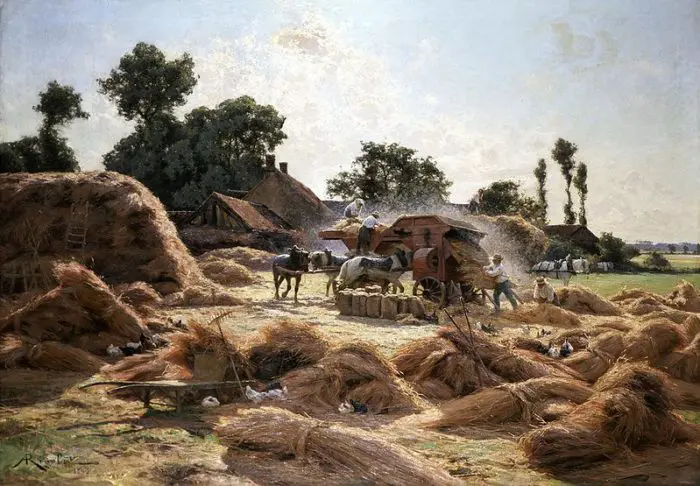Life on the Farm from the Medieval Period to Today
For thousands of years, people have farmed the land to grow food. The shift to settled agriculture may have even been the catalyst for the birth of cities and civilization itself. But what was life like for the people who worked the farms? And how did it change over time?
In this Snapshot. we’ll look back at the life of farm workers from the medieval era until today.

Medieval farm workers thresh the fields in this image from a French book of hours, c. 1412
Medieval Europe was an agrarian society––fewer than 10 percent of the population lived in cities, and somewhere between 80 to 90 percent of the population was involved in farming.
The majority of farmers were peasants who did not own the land. Many farmers, especially before the Black Death, were serfs, tied to the land and forced to serve the lord who owned the land they farmed.
And much of Europe existed at the subsistence level. The Great Famine of 1315, for example, likely killed between 10-15% of Europe’s population due to food shortages.
Farmers used simple tools in the medieval period: ploughs were used to turn the soil, and crops like barley, oats, and grass were reaped with a scythe, an innovation of the 13th century.
Tools like the heavy plow and animal power from oxen increased Europe’s population density and urbanization. But most farmers did not benefit from their labor. Serfs owed their lords compulsory labor as well as a portion of their own crops and fees for milling or selling grain.
Farming methods changed little over the next few centuries, even as more and more farmers left behind serfdom to work as free farmers. Farmers continued to innovate new tools and techniques that increased crop yields, such as a more effective crop rotation.
But life for farmers changed dramatically with the 18th-century Agricultural Revolution. New techniques like rotating turnips and clover increased crop yields, while clearing woodlands, draining fens, and reclaiming pastures increased arable land. The new methods meant that a smaller number of farmers could produce more food.
Even before the introduction of industrial farm machines, these agricultural techniques shrank the number of farm workers. By 1850, only 22 percent of the British workforce was made up of farmers, the lowest in the history of the world.

An eighteenth-century invention to spread liquid manure, an early attempt at mechanized farming
The Agricultural Revolution gave way to the Industrial Revolution, which brought even more dramatic changes for farm workers. Eli Whitney patented the cotton gin in 1794, revolutionizing cotton production by speeding up the process of removing seeds from the cotton fibers. And indirectly, new methods of transportation like the steamboat and the railroad meant that farmers could sell their crops to a wider market.
While machines often replaced farmers, as with the case of mechanical reapers, technology did not always mean fewer farm workers. In fact, the cotton gin increased the demand for slaves in the Southern United States, because it made cotton a more profitable crop. And the ability to transport crops across long distances quickly drove down agricultural prices in the late nineteenth century. As some farmers were pushed out of business, and their land was consolidated by larger businesses, they moved to the cities.

French painter Albert Rigolot’s 1893 “The Threshing Machine” captures the shift to mechanized farm work
These changes had clear political consequences. Farmers in the United States rallied together in the Grange, a political advocacy group formed in 1867. In addition to advocating for lower railroad prices, the Grange helped create a populist political party that fought against big business.
The twentieth century drastically transformed both agriculture and farm workers. At the dawn of the twentieth century, more than half of the U.S. population lived in rural areas where small, diversified farms employed close to half of the U.S. workforce. By the end of the century, a small number of large, specialized farms would dominate rural American and employ less than two percent of U.S. workers.
The change was both due to technology and economics. Farms became more efficient with technology and specialization, and farm sizes grew as small farmers were unable to compete economically.
Since 1900, the number of farms in the United States fell by 63 percent, while the average farm size grew 67 percent. The turning point for U.S. farmers was the Great Depression and the Dust Bowl, harsh droughts in the 1930s. Prices fell; cotton dropped from 35 cents a pound in 1919 to 6 cents a pound in 1931.
Many farmers abandoned their land to look for work elsewhere. Depression, drought, and the high demands of mechanized farming drove the consolidation of agriculture, where large farms became the dominant model. These large farms became increasingly reliant on migrant labor. In short, the workers on large farms were increasingly not the people who owned the land. Today, the vast majority of farm workers are Latin American immigrants, and up to 75 percent of them are undocumented.

Japanese farm workers pick strawberries in California, as captured by photographer Dorothea Lange, 1942
This exploitation of farm workers is not new: in the 1600s, England shipped over indentured servants to work in the field, and they were quickly followed by slaves taken from Africa. In the decades after slavery was abolished, the U.S. imported Asian farm workers; by 1886, nearly 90 percent of farm workers were Asian. The twentieth century brought a new reliance on Latin American farm workers.
In the twenty-first century, farming methods would be unrecognizable to someone from the medieval period. The tools are completely different, as are the techniques and even the crops themselves. And yet the position of many modern farm workers––exploited by large landowners in order to increase profits––is not so far from the life of a medieval farm worker.